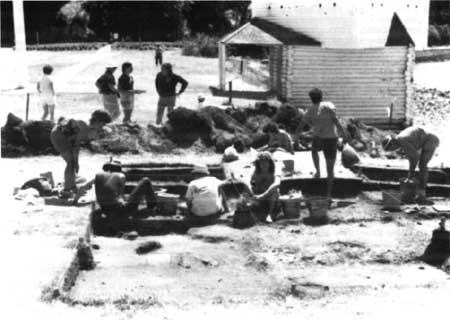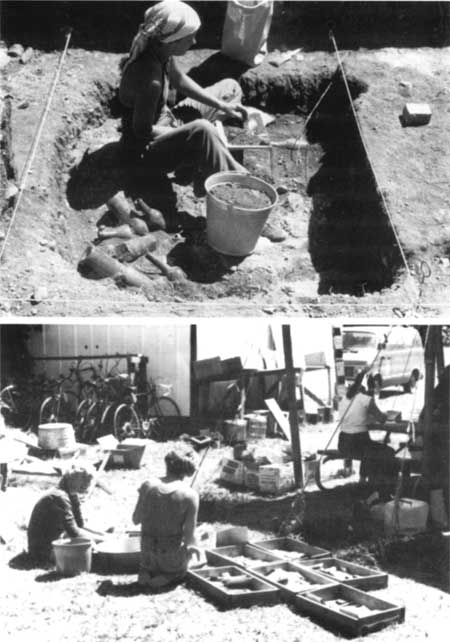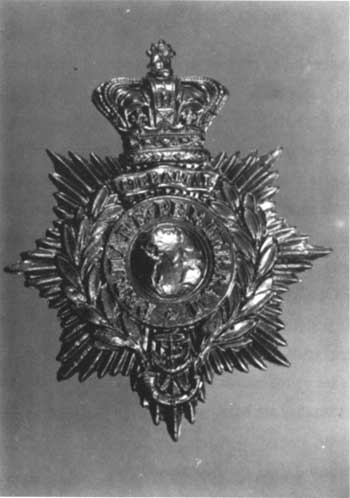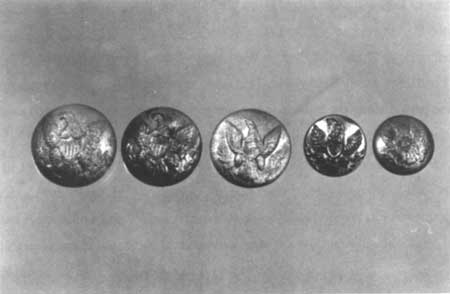|
San Juan Island
Administrative History |

|
CHAPTER 5:
Resource Management
Archaeological Resources
The first recorded archaeological work done on the island was completed by Harlan Smith in the 1890s as a part of the Jesup Expedition, sponsored by the American Museum of Natural History. [13] In the late 1940s and in 1950-51, the University of Washington completed field excavations of known prehistoric long house sites at English Camp and on Cattle Point near American Camp. The findings of these excavations have not been located. Throughout the first half of the 20th century, archaeological sites (both prehistoric and historic) were subject to agricultural developments, timber harvesting, and livestock grazing. Looting by artifact hunters also had an impact.
In 1968, the NPS developed an archaeological management plan for the park. The plan identified known cultural resources and sites at the park, what research had been completed at both sites, and what research was in progress. The plan identified the immediate research needs of the park in order to complete the park's basic operating goals.
Research needs included the identification of all historic structures; the identification of the American Camp cemetery; identification of Bellevue Farm and San Juan Town structures; and the evaluation of the Redoubt. The plan also stressed the need for a historic resource study of the sites.
Two major field schools have been held at the park through cooperative study arrangements with the University of Idaho (1970-78) and University of Washington (1983-90). The research completed by both schools has led to a wealth of artifact materials, both biological and historical, and fueled study on several different levels and topics, from shell middens to analyzing pottery sherds of the late nineteenth century.
University of Idaho
The University of Idaho, Moscow, was the first university the park worked with to complete archaeological studies at the park. From 1970 to 1978, under the leadership of Dr. Roderick Sprague, historical archaeological studies were completed analyzing site structures, including Bellevue Farm and San Juan Town. The goal of the field school's work was identification and stabilization of historic structures.

The University of Idaho field school at work at
English Camp, c. 1970.
At American Camp, over a period of years the field school excavated the following structures: HS 1 Barracks, HS 8 Officers' Quarters, HS 10 Officers' Quarters, HS 11 Officers' Quarters, HS 12 Adjutant's Quarters, HS 13 Hospital, HS 19 Barn, HS 21 Carpenter Shop, HS 29 Woodsheds and Outhouses, HS 31 Post Trader and Billiard Room, and HS 33 Flagstaff. Of these structures, HS 6 and HS 8 were fully excavated. The remaining excavations produced a range of structural evidence from partial foundations or corner establishment to inconclusive structural evidence. The excavations also revealed the effects of rabbit damage. Rabbit burrowing was particularly destructive and compromised the structural evidence of the hospital. General surface collecting was done in areas of high visitor use and trenching was completed along officers' row and the camp fence lines.
At English Camp, the University of Idaho completed excavations first around HS 1 Blockhouse and HS 10 Barracks during reconstruction efforts in 1970-71. Trenching was done along the north, south, and east walls of the blockhouse, revealing evidence of a cobblestone "porch" in front, log cribbing, and one post hole. [14] The structure was completely excavated. The Barracks was also fully excavated and its foundation defined. HS 3 Commissary was also fully excavated, its foundation defined, in addition to the discovery of a Straits Salish long house underneath. Excavations around the hospital location produced some post holes but no conclusive evidence. [15]
In addition, the students completed test pits, trenching, and surface excavations trying to locate or define the following structures: HS 2 Barracks, HS 4 Blacksmith Shop (trenching produced remnants and residue of smithing operations but no conclusive structural evidence), HS 5 Captain's House, HS 6 Married Subaltern's Quarters, HS 11 & 12 Wash and Bath Houses, HS 13 & 14 Wells, HS 15, 16, 17, 31, 32, 33 & 34 unidentified structures (some structural evidence was revealed but primarily produced artifacts), HS 19 Stable, HS 20 Storehouse, HS 21 & 22 Messhouse and Library, HS 23 Carpenter's Shop and Sawmill, HS 24 Wharf, and HS 25 Pier (produce one stone piling). HS 35 Flagpole was located, in addition to the discovery of a complex structure, possibly another Salish structure, underneath. [16]
During the seven-year field school, the University also did test excavations around San Juan Town and Bellevue Farm. Eleven structures were examined at the town site and a great deal of artifact evidence removed for research. The town had some rabbit burrow damage, but most site damage was produced by artifact hunters during the mid-twentieth century. [17] Operations in the Bellevue Farm vicinity produced structural evidence of approximately eight structures, one of which dated post-1900, too recent for an HBC structure. Research of artifact accumulation at those sites to explain structure function succeeded in identifying the kitchen, but little else conclusively.
In 1983, the university produced a two-volume report titled San Juan Archaeology which covers the research completed from 1970-78 and subsequent analysis and research of the excavation findings. A majority of park data resulted in papers and dissertations on ceramics and late nineteenth century trade patterns.
University of Washington
While University of Idaho students completed studies of historic archaeology at the park, the University of Washington (UW) focused on the prehistoric archaeology in the park. In addition to the pre-NPS work done by UW scholars, Stephen Kenady supervised the work being done on the prehistoric sites exposed by the University of Idaho students during the 1970s.
In 1983, Julie Stein and Pamela Ford of the University of Washington, in coordination with PNRO Regional Archaeologist Jim Thomson, developed a research proposal for a field school at English Camp. Superintendent Hastings supported the proposal. Through a cooperative agreement, the university worked at the camp on the San Juan Island Archaeological Project from 1983 to 1989.
The field school focused its efforts on a large shell midden located in the center of the parade ground at English Camp. Students worked during the summers through 1989 examining the midden. The mostly biological artifact evidence extracted for research comprises the collection currently being stored at UW. Analysis of the shell midden data resulted in Deciphering a Shell Midden, edited by Julie Stein and published in 1992. The book details the project's findings regarding lithic technology and manufacture, stratigraphy, sediment analysis, effects of historic settlement, geophysical exploration work, and sedimentary analysis, among other topics. Project archaeologists utilized the site to produce research, documentary evidence patterns, and site treatments that can be used on shell middens elsewhere in the world.

University of Washington field school
student at work; the camp lab, 1984.
Guss Island
Located in Garrison Bay and owned by the park, Guss Island is the site of several prehistoric human burials and a shallow shell midden. The island is considered culturally sensitive due to its use as a sacred burial site and access to the island has been closed to the public since the NPS took stewardship. Unfortunately, this does not prevent people from going to the island.
The low banks of the island have been subjected to a great deal of erosion, which has exposed burials. Visitors discovered and brought to the park headquarters remains exposed in 1970. [18] In 1983, after more burials were exposed, Julie Stein and Pamela Ford conducted a salvage excavation to pull exposed burials from the banks. These remains were given to the Lummi tribe for reinternment elsewhere in the park.
Eroding shorelines will continue to expose burials on the island. Current understanding with the Lummi is that exposed burials be allowed to erode. [19] However, as visitors and islanders become aware of the burials, excavation and reinternment may be considered as a preventative law enforcement measure.
Prehistoric Archaeological Overview and Base Map
In 1988, Dr. Gary Wessen of Wessen and Associates prepared A Technical Overview of Prehistoric Archaeology of the San Juan Islands Region for the Pacific Northwest Regional Office. Wessen provides an excellent review of known prehistoric archaeological sites in the region and reviews what documentation, collections inventory, and final reporting have been achieved for all excavated sites.
The overview begins by offering an environmental assessment of the islands, current conditions vs. paleo-environmental conditions. An ethnographic background of the region is also provided. In both of these background assessments, Wessen describes the islands as a whole and then looks specifically at American and English Camps. Wessen then provides an assessment of prehistoric cultural resources that exist in San Juan County and in the park, including a breakdown of typical site typology.
Wessen concludes that there are 323 recorded prehistoric sites in the islands and possibly hundreds more in existence. [20] Wessen's research concluded that for most of those sites excavated, little is known about them because of incomplete research, reporting, and cataloging/inventory of site evidence. The overview discusses what short, middle, and long term goals should be pursued in order to understand, preserve, and learn from the wealth of sites on the islands and at the parks, and stresses that the sites are deteriorating faster than they are being studied.
Additional Studies
The NPS has completed general survey and Section 106 compliance for all general park construction efforts: trailer pad sites, the headquarters building site, construction of the by-pass road and reestablishment of the old county road portion, among others. As previously stated, survey work of the hillside at English Camp was completed by Bryn Thomas of Eastern Washington State University as part of the Historic Landscape Study field work. This study revealed larger cultural remnants from the historic period along the hillside than were previously known, and which await further study.

Royal Marine medallion, recovered during University of
Idaho field school.

U.S. Army uniform buttons discovered at American
Camp.
Collections Management
The purpose of San Juan Island N.H.P. collections, according to the 1981 scope of collections statement, is to "preserve the archaeological, historical and natural history objects necessary to research, document and interpret the significance of the park." [21] The collection is broken into three management areas: archaeological, historical, and natural history. Archaeological collections consist of materials generated from excavations, and will be maintained through agreements with the University of Idaho, including storage, cataloging, and inventory. Historical collections will be kept on-site, providing they deal with the HBC; the military encampments; settlers specific to the campsites; and a small selection of Crook materials. The scope stated that no natural history objects were currently being maintained, but the document speculated that it could become a viable collection option in the future.
The statement goes on to detail proper procedure in accessioning, cataloging, loaning, de-accessioning, and storing artifacts and items. The living history demonstration materials are identified as needing secured storage separate from the main collection. An addendum to the collections management plan regarding the Native American Graves Protection and Repatriation Act was completed in 1992, well after the park had already returned and reinterred remains affiliated with the Lummi tribe.
Following preparation of the scope of collections, the park negotiated an agreement with the University of Washington to catalogue and maintain artifacts extracted during UW field schools, at the University's Burke Museum in Seattle. Currently, the park's collection contains approximately 935,400 archaeological items, 500,000 of which are prehistoric in nature and reside at UW. The remainder of the collection previously stored at the University of Idaho, contains approximately 400,000 items from the historic period, 1853-1874. During 1992, it no longer became an option to store the collection at the University of Idaho and a cooperative curatorial agreement was reached with North Cascades National Park in return for budgetary assistance from the park. The collection is now stored at the Marblemount collections facility. In addition, approximately 53,000 HBC-related items were sent to Fort Vancouver National Historic Site (FOVA). [22] HBC collections were sent to FOVA as part of a regional mission to make FOVA the center for HBC-related collections and research. In-park collections are stored in a leased storage space in Friday Harbor.

The headstone of William Taylor, from the English Camp
Cemetery.
Recently, the option of a natural history specimen collection has been reviewed by park staff and will be developed in the near future to facilitate the development of a natural resource data base. Park management realizes the need for an updated scope of collections statement to address new collections, and to define the best management of current collections for the next decade.
| <<< Previous | <<< Contents >>> | Next >>> |
http://www.nps.gov/sajh/adhi/adhi5b.htm
Last Updated: 19-Jan-2003